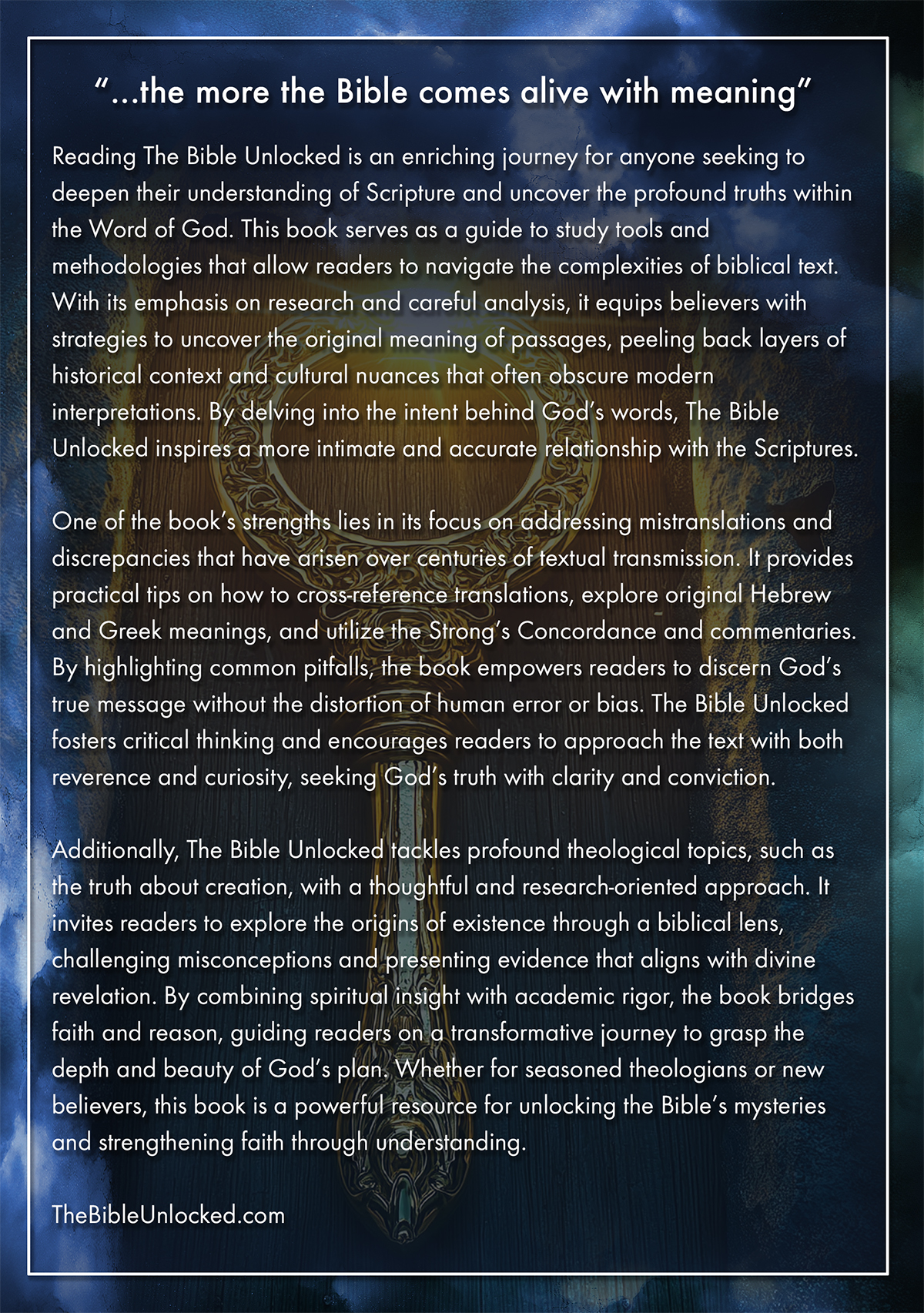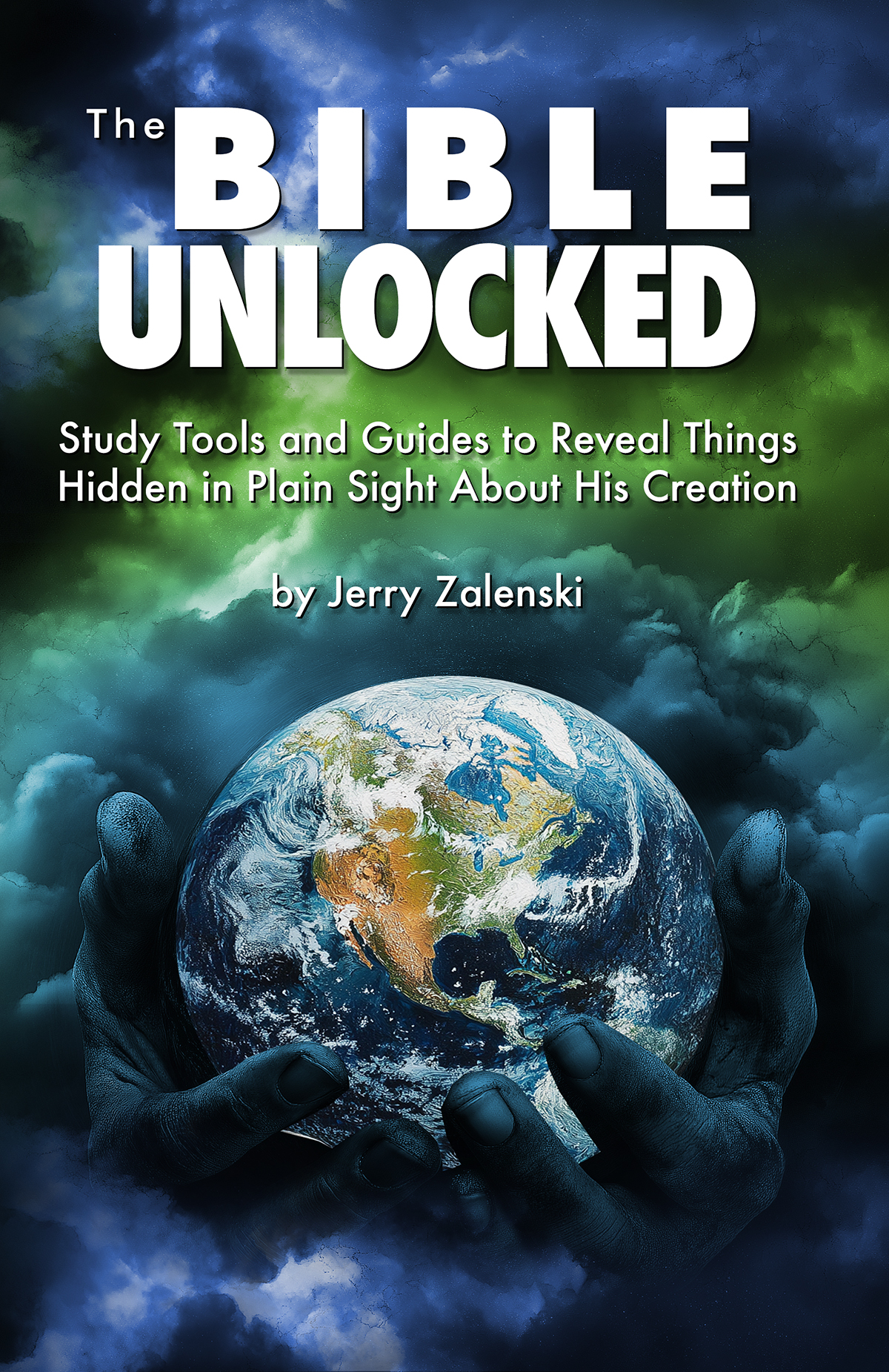

"...the more the Bible comes alive with meaning"
Reading The Bible Unlocked is an enriching journey for anyone seeking to deepen their understanding of Scripture and uncover the profound truths within the Word of God. This book serves as a guide to study tools and methodologies that allow readers to navigate the complexities of biblical text. With its emphasis on research and careful analysis, it equips believers with strategies to uncover the original meaning of passages, peeling back layers of historical context and cultural nuances that often obscure modern interpretations. By delving into the intent behind God's words, The Bible Unlocked inspires a more intimate and accurate relationship with the Scriptures.
CHAPTER 13
- In the Bible, Judas, who betrayed Jesus, is described as dying in two different ways. Why is there a discrepancy? And is he going into the Lake of Fire for what he did?
Let’s address your second question first. Judas repented of his sins and returned the money to the temple. It is not our place to judge his ultimate fate. Only God can make that determination. Leave the judging to Him.
Now, regarding the first part of your question about Judas’ death seemingly being described in two different ways, I would argue there is no true discrepancy. Both accounts from different witnesses can be accurate. Allow me to illustrate this with an example.
Imagine you are walking down a path and see someone hanging from a tree. Naturally, you report that the person hung themselves. Now, consider a different scenario. Before you arrived, a group of individuals may have attacked the victim, placed a rope around their neck, and hung them. You, however, would only see the aftermath and report that the person hung themselves because you lacked knowledge of the prior events.
Extending the example further: after you passed by, the attackers could have returned, cut the victim open, and left the scene. Another eyewitness arriving later might see the body split open and report that detail. In this case, both witnesses describe what they observed, and both accounts are truthful, even though they focus on different aspects of the same event.
Similarly, the accounts of Judas’ death can be understood as complementary perspectives from different witnesses rather than contradictory statements.
- Can you shed some light on the fig tree? Did it die immediately when Jesus spoke to it, or the next day?
In the Book of Matthew, the fig tree appears to have withered immediately after Jesus spoke to it. In the Book of Mark, it is noted that the disciples observed the tree had withered the following day. However, it was Paul who confirmed that it had died instantly. While the timing may appear different from various perspectives, the focus should not be on the exact moment the tree died. Instead, the real question is: What is the meaning or the multiple lessons behind the Parable of the Fig Tree?
Jesus instructed us to “learn the parable of the fig tree.” This begins in the Garden of Eden, where Adam and Eve used fig leaves to cover themselves, symbolizing deeper truths. Understanding the fig tree involves recognizing the distinction between the “good figs” and the “bad figs”, or, in other terms, the difference between the wheat (God’s children) and the tares (Satan’s children). Another key meaning of the fig tree is understanding the season, as Jesus emphasized.
Jesus said, “But pray ye that your flight be not in the winter, neither on the Sabbath day: For then shall be great tribulation, such as was not since the beginning of the world to this time, no, nor ever shall be.”
When Jesus spoke to the fig tree, it was not bearing fruit because it was out of season. The withering of the fig tree serves as a symbolic lesson: Do not be “harvested out of season.” In other words, do not allow yourself to be deceived or taken by Satan prematurely. Instead, wait faithfully for the return of Jesus Christ.
This connects to the passage that says, “One shall be taken, and the other left behind.” Contrary to common interpretation, being “taken” first refers to being deceived and taken by Satan. You want to remain steadfast, putting on the Gospel Armor of our Lord and Savior Jesus Christ. Stand firm, resist Satan, and wait for Christ’s return.
- Did God forsake Jesus when He was on the cross?
Let’s approach this with some common sense. No, God did not forsake Jesus. God would not forsake Himself. When Jesus cried out, “My God, my God, why hast thou forsaken me?” He was quoting Psalm 22. By doing this, Jesus pointed us to that Scripture, affirming His identity as the Messiah and fulfilling prophecy. Even in His final moments, Jesus continued to teach and guide us.
A related question is often asked. Why do the Gospels report different words spoken by Jesus on the cross? The answer lies in the perspectives of the witnesses. Each Gospel writer recorded what they personally saw and heard, providing complementary accounts that together offer a fuller picture of those profound moments.
- Why do some Bible versions include Jesus’ statement, “He who is without sin, cast the first stone,” while others do not?
Over time, Biblical scholars have identified variations in ancient manuscripts. Some early copies of the Gospel of John omit this passage, while later versions include it. This discrepancy stems from differences in translation and manuscript discovery rather than a contradiction in Jesus’ teachings. The account of Jesus and the adulterous woman is consistent with His message of grace and mercy, aligning with the overall narrative of the Gospels.
- When we die, are we immediately with the Lord, or do we sleep until judgment?
Both statements hold truth, depending on the context. Scripture teaches that we possess two bodies: an earthly body (terrestrial) and a spiritual body (celestial). When our earthly body dies, it is described as “sleeping” and returns to dust. This is not a literal sleep but a metaphor for physical death.
However, the spirit immediately departs to a place of paradise, awaiting final judgment. Paradise is described as having two sides, separated by a gulf. Those who have repented and believed in Jesus Christ reside on the right side, while others remain on the left, awaiting the teachings in the millennium and then Judgment Day.
On Judgment Day, our spiritual bodies are judged. Some will receive eternal rewards, while others face separation from God. Understanding this dual reality helps reconcile the Scriptures that describe both immediate presence with the Lord and future judgment.
- What is the difference between your spirit and your soul?
Simply put, your soul is your essence, while your spirit is the intellect or consciousness of the soul.
This distinction can be difficult to grasp, especially when considering how we transition between different states: from a spiritual body in the First Earth Age, to a human body in this Earth Age, and then back to a spiritual body in the final Heaven and Earth Age.
Let’s use the hermit crab to illustrate this concept. A hermit crab must find a shell, or host, to inhabit, or it cannot survive. It might live in shells from sea snails, bivalves, scaphopods, or even hollow wood and stones. Yet, no matter which shell it occupies, it remains the same hermit crab.
Similarly, your soul and spirit remain the same regardless of the “host” they occupy, whether that host is a spiritual body, a flesh body, or something else.
Here’s another example. When you step into a car, the car becomes a host to your body. It transports you to places, but if mishandled, it could harm or even kill you. If you board a plane, the plane becomes the host to your body for the journey.
Can the body itself host other entities? Absolutely. It can harbor viruses, bacteria, infections, and more. On a deeper level, depending on the faith of the soul and spirit, the body can also host either malevolent entities, like evil spirits, or benevolent ones, such as the Holy Spirit.
This is where people often misunderstand spiritual bodies, thinking they’re merely insubstantial, like air. However, spiritual bodies have mass. How do we know? According to the Bible, fallen angels, including Satan, were capable of impregnating human women, which clearly implies they possessed physical mass.
To help broaden your perspective, consider this. A spiritual body could be likened to the most advanced computer or robot imaginable. Its “skin” might look and feel like flesh, but it’s crafted with extraordinary precision. Its “brain” would have perfect functionality, with 100% recall. If a part becomes defective, it could theoretically be replaced, much like components in a computer. Does this analogy sound strange? Perhaps. But the point is to illustrate that a spiritual body isn’t just empty space; it’s something tangible, though we don’t fully comprehend its nature.
- Where Do the United States and Russia Fit in the Bible?
Many people often ask how the United States and Russia relate to the Bible and where various peoples originate. A thorough study of the Bible is necessary to understand the origins of the many families and nations. Here are a few key groups and their connections.
Hagar was Abraham’s concubine and the mother of his son Ishmael. Hagar, an Egyptian servant to Abraham’s wife Sarah, bore Ishmael at Sarah’s request. Ishmael had twelve sons, who became the ancestors of the Arab nations we know today.
Abraham and Sarah later had a son, Isaac, who fathered two sons: Jacob and Esau. Esau’s descendants, through the Hebrew tongue, became known as Rosh, which later evolved into Roush and, ultimately, modern-day Russia.
In approximately 721 BC, the Assyrian army captured the ten northern tribes of Israel. These tribes were exiled and scattered across the Assyrian Empire. Many of them crossed the Caucasus Mountains (from which the term Caucasians originates) and migrated into Europe, Canada, and the United States.
Zedekiah was the last king of Judah before the Babylonian invasion by King Nebuchadnezzar II in 587 BC. God had instructed Zedekiah to accept Babylonian captivity for seventy years, promising protection and prosperity during this time. Zedekiah initially agreed, forming a covenant with God. However, due to pride, Zedekiah broke this covenant, seeking to rebel against Nebuchadnezzar by hiring warriors from Egypt.
Breaking a covenant with God has serious consequences. When Zedekiah turned his back on God, he lost divine protection. Nebuchadnezzar discovered Zedekiah’s rebellion, captured him, killed his ten sons in his presence, gouged out his eyes, and imprisoned him in Babylon, where he eventually died.
Some scholars claim this marked the end of Israel, but they overlook Zedekiah’s daughters. The prophet Jeremiah took these daughters to safety in Egypt. From there, they traveled to Spain, Gibraltar, Cornwall, and ultimately Ireland. One daughter, Tea-Tephi, became Queen of Ireland, while the other, Tamar-Tephi, became part of the British monarchy. Through her lineage came King James, who commissioned the 1611 King James Bible.
Jacob, who was renamed Israel, had many sons, each fathering distinct tribes:
- Levi: From Levi came the priestly line. All Levitical priests descend from this tribe, though not all Levites were priests.
- Judah: The Jewish people trace their lineage to Judah. All Jews are Israelites, but not all Israelites are Jews.
- Joseph: Joseph’s son Ephraim’s descendants migrated to Great Britain, while his son Manasseh’s descendants eventually migrated to the United States.
- Understanding these ancestral connections offers a deeper perspective on the Biblical origins of nations and their roles in history.
- What is the difference between a Disciple and an Apostle, and between Pharisees and Sadducees?
- Disciple: The term “disciple” comes from the same root as “discipline” and refers to someone in training. Disciples are learners who follow a teacher.
- Apostle: Apostles are those who have completed their training and are sent out to teach and share what they have learned.
- Pharisees: The Pharisees believed in life after death but did not recognize Jesus as the Messiah.
- Sadducees: The Sadducees did not believe in life after death and also did not accept Jesus as the Messiah.
- I have friends and loved ones who are gay. How can I help them change their ways?
It is unfortunate when people feel compelled to change others to fit their own perspectives. Instead, a Christian should focus inward, striving to be a positive example for others to follow. Beyond that, it is enough to plant seeds of love and understanding.
Let’s consider the facts. There is nothing wrong with one person loving another, regardless of gender. There is nothing inherently wrong with two people of the same gender living together. However, the Bible addresses the sexual act itself, describing it in several passages, (seven in the Old Testament and six in the New Testament) as unnatural and an abomination to God. These Scriptures express this viewpoint through examples, idioms, and analogies.
It is important to remember that anything unnatural, according to Scripture, glorifies Satan. Should we attempt to change others? No. Let them exercise their God-given free will to make their own decisions.
If, during their journey, they come to realize that their actions glorify Satan, they may choose to change. But ultimately, the decision is theirs.
Let us also reflect on Scripture. In the end times, it will be like the days of Sodom and Gomorrah, marked by moral decline. The prophecy speaks of marriages to fallen angels, with part of this prophecy already fulfilled and the rest yet to come. Recognizing that prophecy cannot be changed, we should accept people for who they are.
Instead of trying to change others, love them unconditionally, lead by example, and plant seeds of truth. After that, move forward, trusting God’s plan for everyone.
- How Do I Plant Seeds?
Planting seeds can be as simple as performing an act of kindness. Offer a smile, uplift someone who is feeling down, or assist the elderly. Every kind gesture reflects God’s love.
At the start of this writing, I discussed what to look for in a church. If you are part of a church that aligns with those principles, consider supporting their ministry through tithing.
The most effective way to plant a seed about the Bible is by asking a simple question and then stepping back. If someone is interested, they will ask for more information.
For instance, I began this piece by posing questions. If you continued reading, it means you were curious and wanted to learn more. This is the essence of planting a seed, sparking interest without overwhelming others. For those with deep Bible knowledge, the challenge often lies in sharing just enough and knowing when to stop. I have personally struggled with this. The desire to share everything can lead to overloading the listener.
Use discernment. Ask a question and allow the other person to guide the conversation according to their curiosity. If they are not interested in hearing more, respect their space. They may not be ready yet.
By maintaining your credibility and demonstrating patience, people may return to you with questions when the time is right.






